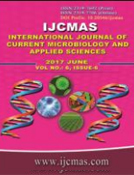


 National Academy of Agricultural Sciences (NAAS)
National Academy of Agricultural Sciences (NAAS)

|
PRINT ISSN : 2319-7692
Online ISSN : 2319-7706 Issues : 12 per year Publisher : Excellent Publishers Email : editorijcmas@gmail.com / submit@ijcmas.com Editor-in-chief: Dr.M.Prakash Index Copernicus ICV 2018: 95.39 NAAS RATING 2020: 5.38 |
Some studies have been carried out to examine the phytochemical and nutritional properties of several plants in South-South Nigeria, but relatively none has compared these properties in leaf, stem and root of any of the plants. This study was aimed at comparing the photochemical and nutritional compositions of the leaf, stem and root of Spondias mombin. The leaf, stem and root were processed and analysed for proximate values (moisture, ash, fat, protein, fibre and carbohydrate), minerals (Na, K, Ca, Fe, Mg, Mn and P), vitamins (A, B1, C, D and E) and phytochemical properties (alkaloids, flavonoids, saponins and tannins) using standard methods. Results showed that the root was richest in moisture (35.78+0.31%) followed by the leaf (32.59+0.08%) which is also richest in carbohydrate (32.08+0.66%). The stem was richest in ash (24.52+0.20%). The leaf, stem and root each had more than 2mg/100ml of vitamin B1 and more 1mg/100ml of vitamin C. For both proximate values and vitamins, there was a significant difference (P<0.05) between the leaf, stem and root. Regarding mineral and phytochemical properties, there was no significant difference (P>0.05) between the leaf, stem and root. The mineral contents for leaf and stem were respectively richest in K (8.61+0.20mg/l, 8.68+0.10mg/l, while the leaf and stem were richest in Na (4.52+0.20mg/ml and 4.21+0.20mg/l respectively). The stem was richest in alkaloids (3.40+0.20mg/100ml) and saponins (4.30+0.8mg/100ml) while the leaf was richest in flavonoids (3.10+0.20mg/100ml). The leaf was also richest in tannins (0.80+0.09mg/100ml), indicating that different parts of the plant have different medicinal properties. In conclusion, the leaf, stem and root of the plant have different phytochemical and nutritional properties and will individually be effective for different uses. It was found that the plant contains pyhtochemicals of medical importance and therefore can be used medicinally.
 |
 |
 |
 |
 |